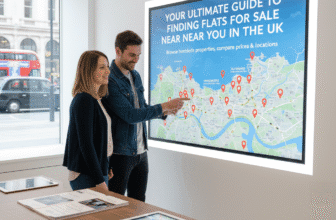
Houses for Sale Near Me: Your Ultimate Guide to Finding a Dream Home in the UK
That simple search, “houses for sale near me,” is the digital starting pistol for one of life’s most exhilarating and occasionally overwhelming journeys. It’s a phrase brimming with possibility, the first step towards finding not just a property, but a home—a backdrop for future memories, a sanctuary from the world, and a significant financial investment. Here in the UK, the path from browser window to front door is a unique tapestry woven with local nuances, historical quirks, and specific legal processes. This guide is designed to be your trusted companion, demystifying the process and empowering you to navigate the British property market with confidence, turning that simple search into a successful reality.
The Modern House Hunt: Mastering Your Online Search
Your quest will almost certainly begin online. The days of trudging from one estate agent window to another are largely over, replaced by the convenience of property portals. In the UK, two giants dominate this space: Rightmove and Zoopla. Think of them as your digital gateways to virtually every property on the market.
To get the most out of these platforms, you need to think like a power user. Don’t just enter your town and hit ‘search’. Dive deep into the filters. You can specify the number of bedrooms, the property type (we’ll explore these later), and of course, your price range. But the real magic lies in the advanced features. Use the ‘draw a search’ tool to outline your ideal area with pinpoint accuracy, perhaps tracing the catchment area of a desirable school or ensuring you’re within a ten-minute walk of the train station. Set up instant alerts; in a fast-moving market, the best properties can be under offer within days, and these email or push notifications give you a crucial head start.

Beyond the headline features, look for the less obvious clues. Scrutinise the floor plan. Does the layout flow logically? Is there enough storage? Check the property history. How long has it been on the market? Has the price been reduced? Both Rightmove and Zoopla offer invaluable ‘sold prices’ sections, allowing you to see what similar houses on the same street have recently sold for. This is vital intelligence when it comes to making an offer. While the big two are essential, don’t discount OnTheMarket, a portal set up by estate agents themselves, which often lists properties for 24 hours before they appear elsewhere.
Beyond the Pixels: The Indispensable Role of Estate Agents
In the digital age, it can be tempting to view estate agents as mere gatekeepers to the properties you’ve already found online. This is a mistake. A good local estate agent is an invaluable source of on-the-ground knowledge and can become your greatest ally. They work for the seller, but their success depends on making sales, which means they need to cultivate relationships with serious buyers.
Instead of just calling about a specific listing, take the time to register with a few of the most active agents in your target area. Visit their office or have a detailed phone call. Be specific about what you’re looking for, but also be open to their suggestions. They will know about properties that are about to come onto the market, or ‘off-market’ opportunities from sellers who prefer a discreet sale. They understand the local micro-markets, knowing which streets are most sought-after and which offer the best value. Building a rapport with an agent means you’ll be at the forefront of their mind when the perfect property lands on their desk.
Location, Location, Location: Choosing the Right ‘Near Me’
The property itself is only half the story. You are also buying into a neighbourhood, a community, and a lifestyle. Thoroughly researching the location is non-negotiable. What does ‘near me’ truly mean to you?
Commuting and Transport Links
Map out your daily commute. If you rely on public transport, check the frequency and reliability of train or bus services. How far is the walk to the station? If you drive, test the route during rush hour. Consider future infrastructure projects. Is a new train line or road improvement planned that could enhance the area’s connectivity and, by extension, your property’s value?
Schools and Amenities
Even if you don’t have children, the quality of local schools has a significant impact on property desirability and prices. Check Ofsted ratings for nearby primary and secondary schools. Beyond schools, what makes a location liveable for you? Walk around the area at different times of the day and on different days of the week. Is there a welcoming pub? A decent local shop for a pint of milk? A green space for a weekend stroll? How far is the nearest GP surgery or supermarket? These everyday conveniences are the bedrock of a happy home life.
Community and Vibe
Every neighbourhood has its own unique character. Some are bustling and vibrant, others are quiet and sleepy. The only way to understand this is through immersion. Spend a weekend exploring. Have a coffee in a local café, browse the shops, and observe the people. Look for community noticeboards or local Facebook groups to get a sense of local life, events, and any potential issues. This is your chance to gauge whether the area’s personality aligns with your own.
Future Development
A little-known but powerful research tool is the local council’s planning portal, available online. Here, you can search for planning applications in the vicinity of a potential home. Is there a major housing development planned at the end of the road? Is the pub down the street seeking permission for a late-night license? This information can reveal future changes that could either enhance or detract from your enjoyment of the property.
Decoding Property Types: What’s on Offer in the UK?
The UK boasts a diverse and often confusing array of property types. Understanding the terminology is essential for refining your search.
- Detached: A standalone house that does not share any walls with another property. These typically offer the most privacy and often have larger gardens, but they usually come with the highest price tag.
- Semi-Detached: A pair of houses joined together by a common wall. A classic British suburban staple, offering a balance between space and affordability.
- Terraced: A house that forms part of a row, sharing walls with neighbours on both sides. End-of-terrace properties share only one wall and are often more desirable. These are common in urban areas and can range from charming Victorian cottages to larger townhouses.
- Bungalow: A single-storey dwelling. Popular with those seeking to avoid stairs, bungalows are often in high demand and can command surprisingly high prices due to their relative scarcity.
- Flats and Apartments: Individual residences within a larger building. A key distinction here is between ‘leasehold’ and ‘freehold’. Most flats in England and Wales are leasehold, meaning you own the right to occupy the property for a set period (the lease), but not the building or the land it stands on. You’ll likely have to pay ground rent and service charges. Freehold means you own it all outright, which is more common with houses.
You’ll also encounter a choice between period properties and new builds. Period homes—from Georgian townhouses to Victorian terraces and 1930s semis—offer character and charm but may require more maintenance. New builds offer modern amenities, energy efficiency, and often come with a warranty, but can sometimes lack the unique character and generous proportions of older homes.
The Viewing: How to Inspect a Property Like a Pro
Once you’ve found a promising candidate, the viewing is your opportunity to play detective. Look beyond the seller’s beautifully arranged furniture and freshly brewed coffee. Be methodical.
Start with the exterior. Look up at the roof. Are there any missing or slipped tiles? Check the guttering and drainpipes for signs of blockages or damage. Examine the brickwork or rendering for any large cracks. Inside, your nose is one of your best tools. A musty smell can be a tell-tale sign of damp. Look for peeling wallpaper, flaking paint, or dark patches, particularly at the base of walls and in corners. Don’t be shy—ask to turn on taps to check the water pressure. Open and close windows and doors to see if they stick. Check for storage; it’s something many people overlook until it’s too late.
Ask questions. How old is the boiler? When was the property last rewired? What are the average utility bills? What is the council tax band? A good estate agent will have this information to hand. Try to get a feel for the property’s orientation. A south-facing garden will get sun for most of the day, a huge selling point in the UK. Finally, always try to arrange a second viewing at a different time of day to see the property in a new light and check for things you might have missed the first time.
From Offer to Keys: Navigating the Buying Process
You’ve found ‘the one’. Now comes the formal process of making it yours. The first step is to make an offer, usually through the estate agent. This is where your research on sold prices comes into its own. Before you do this, it is highly advisable to have a Mortgage Agreement in Principle (AIP) from a lender. This shows the seller that you are a serious, credible buyer who can secure the necessary funds.
Once your offer is accepted, the real legal work begins. You will need to instruct a solicitor or a licensed conveyancer to handle the legal transfer of ownership. They will perform local authority searches to uncover any planning issues or restrictions, check the title deeds, and handle all the contractual paperwork. At the same time, you will formally apply for your mortgage, and your lender will arrange for a mortgage valuation survey to confirm the property is worth what you are paying for it.
It is strongly recommended that you commission your own, more detailed survey. A RICS HomeBuyer Report is suitable for conventional properties in reasonable condition, while a full Structural Survey is advisable for older, larger, or more unusual homes. This survey is your health check on the property and can uncover issues that could allow you to renegotiate the price or, in a worst-case scenario, walk away from a potential money pit.
The culmination of this process is the ‘exchange of contracts’. This is the point of no return. You pay your deposit, and the agreement becomes legally binding. ‘Completion’ is the final step, usually a week or two later, when the remaining money is transferred, and you receive the keys to your new home. Congratulations, you are now a homeowner!
Your Journey Starts Now
That initial search for “houses for sale near me” is the start of a significant chapter. It requires diligence, research, and a level head. By mastering the tools at your disposal, building strong relationships, and knowing what to look for beyond the superficial, you can navigate the market effectively. Remember to look past the paint colours and see the bones of the building, to consider the community as much as the commute, and to prepare yourself for the legal and financial journey ahead. It’s a path of many small steps, but one that ultimately leads to a place you can call your own.







